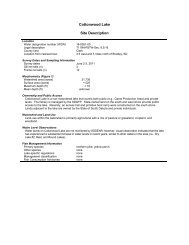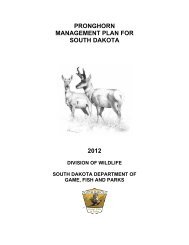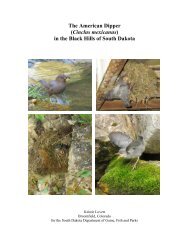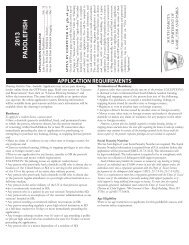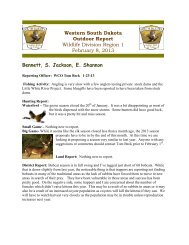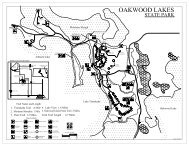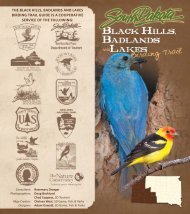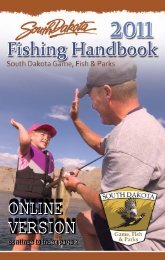pdf version - South Dakota Department of Game, Fish and Parks
pdf version - South Dakota Department of Game, Fish and Parks
pdf version - South Dakota Department of Game, Fish and Parks
You also want an ePaper? Increase the reach of your titles
YUMPU automatically turns print PDFs into web optimized ePapers that Google loves.
Yellow Perch<br />
Perca fl avescens<br />
Quick key characteristics: The yellow perch is found in primarily coolwater<br />
habitats. Its scales are moderate in size <strong>and</strong> readily visible. It has two<br />
separated <strong>and</strong> elongated dorsal fi ns, one (in front) with sharp spines instead<br />
<strong>of</strong> rays. Its second dorsal fi n <strong>and</strong> anal fi n each have two spines. Its pelvic<br />
fi ns may be orange or red. It has a large, forward-facing mouth that extends<br />
backward to the pupil <strong>of</strong> the eye <strong>and</strong> a pointed snout. Its body is taller than<br />
wide <strong>and</strong> greenish-yellow, with 6 to 7 dark vertical stripes extending across<br />
the back, reaching to the lower sides.<br />
Similar species in <strong>South</strong> <strong>Dakota</strong>: none<br />
Range: The yellow perch is native to northeastern North America. In <strong>South</strong><br />
<strong>Dakota</strong>, it is native in river basins northeast <strong>of</strong> the Missouri River, but widely<br />
introduced elsewhere.<br />
Items <strong>of</strong> interest:<br />
• Feeds primarily on crustaceans, insects, molluscs, <strong>and</strong> small fi shes<br />
• Eggs are contained in tubular, “accordion-like” str<strong>and</strong>s, usually<br />
deposited over submerged vegetation or brush<br />
• Popular sport fi sh<br />
• May exceed 15 in. <strong>and</strong> 2 lbs.<br />
61






